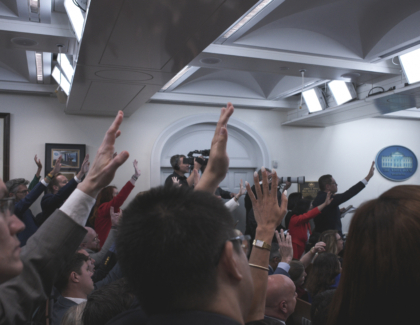Sign up for the daily CJR newsletter.
After Super Tuesday, Narrative-Shift Wednesday. Yesterday, 14 states, plus American Samoa and Democrats living abroad, voted. Bernie Sanders, the prior Democratic frontrunner, won three of them, and is on track to win California, which awards more delegates than any other state; otherwise, Joe Biden—revitalized since his big win in South Carolina on Saturday—swept the board, winning nine states including Texas, Virginia, North Carolina, Massachusetts, and Minnesota. (Maine is still too close to call.) Biden’s resurgence—just weeks after many pundits all but wrote off his campaign following its fifth-place finish in New Hampshire—marks another whiplash moment in a primary season that’s been full of them.
Should we have seen this one coming? Perhaps, though as Astead W. Herndon, a politics reporter at the New York Times, tweeted last night, plenty of contingencies—Elizabeth Warren taking out Michael Bloomberg at the debates; South Carolina Rep. Jim Clyburn endorsing Biden; Pete Buttigieg and Amy Klobuchar dropping out and backing Biden, too—have entered play since New Hampshire. Journalists and pundits love to post-rationalize, but in politics, nothing is inevitable.
ICYMI: Why did Matt Drudge turn on Donald Trump?
Another key factor behind Biden’s renaissance? The media. As one Biden aide put it, he rode an “earned media tsunami” heading into Super Tuesday; after South Carolina, CNN’s Brian Stelter noted, Biden profited from “made-for-TV moment after made-for-TV moment.” (Earned media refers, essentially, to airtime a candidate didn’t pay for, like when MSNBC carried Biden’s Monday-night rally with Klobuchar and Beto O’Rourke without interruption at significant length.) According to one firm that monitors such things, Biden’s earned media between polls closing in South Carolina and yesterday evening may have topped $70 million in monetary value. That’s a lot of earning.
Advertising, nontraditional media platforms, and other, non-media dynamics also play roles, of course. Nonetheless, as Sam Stein and Maxwell Tani reported last week for the Daily Beast, it appears, in this cycle, as if “the main thing that is moving the electorate is the national media and there’s not really a close second.” Aides to every major Democratic campaign told Stein and Tani that they’ve “been stunned by the degree to which the conversation taking place on cable and national news has impacted the trajectory of the race.” This conclusion elicited some pushback online. If cable news is so crucial, how come Sanders—who, it is safe to say, is not a favorite of the TV pundit class—is doing so well; if ad dollars matter less, how to explain Michael Bloomberg’s rapid, cash-fueled rise in the polls?
These were—and still are—legitimate questions that point to a complex picture. Still, Biden’s performance since they were raised—along with Bloomberg’s struggles yesterday—looks like clear proof that news narratives count for a lot. As the Super Tuesday results came in, several political reporters pointed out that Biden did very well in areas where he was massively outspent by other candidates, and where he had little ground game or infrastructure to speak of. (Biden’s campaign pushed back on aspects of this characterization.) This phenomenon is hardly unprecedented. By roughly this point of the 2016 cycle, Donald Trump was running a relatively light operation and had spent less on ads than five of his Republican rivals (as well as Sanders and Hillary Clinton)—and yet he was already on his way to $2 billion worth of earned media, orders of magnitude beyond any other candidate. We all know how that one turned out.
In other words, what we say matters. A lot. Many journalists, it would seem, like to conceive of themselves as being above the fray—impartial observers who listen to what voters are thinking and report it back to them. In practice, we exist as part of a messy feedback loop; our judgments—who’s electable, who isn’t; who’s surging, who’s not—are crucial in shaping what voters think. A key reason that this Democratic primary season has felt disorienting is that we’ve shuffled through contradictory narratives at a dizzying pace. O’Rourke is one to watch; now he’s out. Buttigieg is on a roll; now he’s out. Warren is the frontrunner; Warren was the frontrunner for about five minutes. Bloomberg is killing on TV; Bloomberg has been killed on TV. Amy has Klomentum; Biden has Joementum. Sanders is inevitable; now he’s hanging on.
Barring a stunning fightback from Bloomberg or Warren (or *insert obligatory mention of Tulsi Gabbard here*), we now, finally, have a two-horse race: Biden v. Sanders. That gives political media—and cable news executives, in particular—a rare chance to reset; we can stop chasing flavors of the month and making bad predictions, and instead focus on the very clear, substantive choice facing the Democratic Party and the country. As Matthew Yglesias, of Vox, tweeted last night, of Biden’s surge, “[me, drunk with power] Earned media rules everything!” It’s time to sober up, and end the whiplash.
Below, more on Super Tuesday and 2020:
- Burisma’s back, alright?: With Biden back at the top of the Democratic field, Republicans may redouble their efforts to cast aspersions on his son Hunter, and his role on the board of the Ukrainian gas company Burisma. (The Hunter Biden narrative was at the center of Trump’s impeachment trial, if you can remember that far back.) This week, we learned that Ron Johnson, Republican senator for Wisconsin, is planning to subpoena a witness linked to Burisma. Susan Hennessey, of Lawfare, argues that the media is “embarrassing” itself by taking Republicans’ Burisma claims seriously.
- Boon companion: For CJR and the Tow Center for Digital Journalism, Sam Thielman and Ishaan Jhaveri analyzed where Bloomberg’s TV ad spend has been going. His outlay, Thielman and Jhaveri write, “is both a bid to bypass mediators like the press and the party machine, and a huge financial boon to local newsrooms across the country, where station-level advertising is a primary source of income.”
- Swoon companion: Perhaps no candidate this cycle benefited from earned media as much as Buttigieg, whose aggressive courting of the political press elevated him from obscurity to genuine contention. After he dropped out, “reporters and pundits gave him a final swoon, for old time’s sake,” Politico’s Jack Shafer writes. “As if crowding onto a packed subway car, the commentariat jostled to pay homage to Buttigieg’s future.”
- Last night’s other races: Super Tuesday also saw some intriguing contests down ballot, on both sides. Jeff Sessions, who gave up his Senate seat in Alabama to become Trump’s first attorney general, is trying to win that seat back; yesterday, he qualified for a runoff election against Tommy Tuberville, the former Auburn University football coach, with the winner set to face Democrat Doug Jones in November. (Roy Moore, who Jones beat in 2017, is now out of contention.) On the Democratic side, Henry Cuellar, a moderate congressman from Texas, is currently beating a progressive challenger, Jessica Cisneros, in a race which courted widespread media attention. And Young Turks founder Cenk Uygur’s bid to be a congressman in California has fallen flat.
- Obstacles to voting: In some places yesterday, people had to wait in line for hours in order to vote. The issue occasionally punctuated cable news coverage last night; on MSNBC, Rachel Maddow called the obstacles to voting “an outrage.”
Some news from CJR: Last April, CJR and The Nation cofounded Covering Climate Now, a global journalism initiative committed to more and better coverage of the defining story of our time. The project has grown to include more than 400 news outlets, including The Guardian, CBS News, and Reuters, with a combined audience approaching 2 billion people. All bona fide news outlets are invited to join; there is no financial cost nor editorial line, except respect for climate science. Last September, we organized a week of high-profile coverage around the UN Climate Action Summit that helped drive a massive increase in overall media coverage of the climate story. That’ll happen again April 19-26, with a week of climate-solutions coverage coinciding with the 50th anniversary of Earth Day. In the meantime, The Climate Beat, Covering Climate Now’s newsletter, analyzes highlights best practices in media climate coverage, and is co-published every other Wednesday by CJR and The Nation. You can read it here.
Other notable stories:
- Last week, Trump’s reelection campaign sued the Times for libel, citing a 2019 opinion piece on Trump and Russia. Yesterday, the campaign sued the Post on similar grounds, targeting two more op-eds, also on Trump and Russia, by Greg Sargent and Paul Waldman, respectively. Charles Harder, the hard-charging lawyer who represented Hulk Hogan in the suit that bankrupted Gawker, is representing the campaign in both suits. First Amendment experts have called the suits baseless, and part of a war on the press.
- Yesterday, Vice President Mike Pence led a briefing on the coronavirus that news outlets were banned from recording. Pence said he expects there’ll be an on-camera briefing today. In other Trump-administration news, the White House is still reviewing John Bolton’s (reportedly) explosive book, which was slated to be published in two weeks, but now won’t appear until May, at the earliest. Trump reportedly wants to block the book.
- On Monday, Richard Burr and Mark Warner—respectively, the top Republican and Democrat on the Senate Intelligence Committee—asked Richard Grenell, Trump’s acting director of national intelligence, to publish the government’s conclusion that Saudi Crown Prince Mohammed bin Salman was behind the killing of Jamal Khashoggi. If Grenell says no, the Senate may still be able to release the assessment, under a little-used law.
- Last year, police in San Francisco raided the home of Bryan Carmody, a freelance journalist and stringer who had obtained a sensitive internal report. The city’s police chief subsequently acknowledged that the search was likely illegal (California has a shield law protecting journalists). Carmody sued; recently, San Francisco agreed to pay him $369,000 in compensation. (Last year, Tony Biasotti tracked the case for CJR.)
- For CJR, David Roth laments that many news sites are neglecting a core function: being easy to read. Even on those of august institutions, Roth writes, “ads interrupt the text every two paragraphs; ads follow you down the sides of the page like store security; ads pop up in boxes that resist being closed, the elusive little x evading your cursor.”
- For the Post, Ben Strauss writes that the future of sports writing may depend on The Athletic, “which is either reassuring or terrifying.” Since its launch in 2016, the site has aggressively expanded its staff, offering lifelines to reporters who lost jobs elsewhere—but questions remain as to the long-term viability of its business model.
- For CJR’s Year of Fear series, featuring dispatches from places where local news is struggling, Sandra Sanchez reports from South Texas, where Tricia Cortez, an expert on the Rio Grande, is informing people about—and organizing against—Trump’s border wall. Cortez says her local paper, the Laredo Morning Times, has “sadly atrophied.”
- And Mary McNamara, of the LA Times, took issue with Ben Smith’s debut media column for the New York Times, in which Smith argued that his paper’s success may be bad for journalism. “Under the guise of analysis,” she writes, “Smith praises his new employer in prose as breathless as an ‘omg you’re so stunning I hate you’ Instagram reply.”
ICYMI: The new coronavirus and racist tropes
Has America ever needed a media defender more than now? Help us by joining CJR today.







